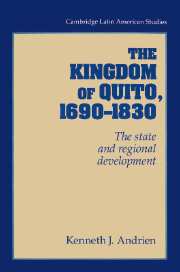Book contents
- Frontmatter
- Contents
- Acknowledgments
- Introduction
- PART I THE STATE AND SOCIOECONOMIC DEVELOPMENT
- PART II REFORM AND POLITICAL CONFLICT
- 7 Political turmoil and economic decline, 1690–1778
- 8 The price of reform, 1778–1830
- 9 Conclusion: the state and regional development
- Appendixes
- Glossary
- Bibliography
- Index
8 - The price of reform, 1778–1830
from PART II - REFORM AND POLITICAL CONFLICT
Published online by Cambridge University Press: 29 September 2009
- Frontmatter
- Contents
- Acknowledgments
- Introduction
- PART I THE STATE AND SOCIOECONOMIC DEVELOPMENT
- PART II REFORM AND POLITICAL CONFLICT
- 7 Political turmoil and economic decline, 1690–1778
- 8 The price of reform, 1778–1830
- 9 Conclusion: the state and regional development
- Appendixes
- Glossary
- Bibliography
- Index
Summary
When José García de Leon y Pizarro arrived in the Kingdom of Quito in 1778, he began implementing a series of policies aimed at making the administrative structure of the state more centralized and efficient. These innovations formed part of an empire-wide program of reform to realize the ambitious fiscal, commercial, and defense goals of King Charles III (1759–88) and his ministers. García Pizarro was a well-connected politician, given extraordinary political, judicial, fiscal, and military powers by the Madrid government. Despite formidable local opposition, he used this authority and influence to become the towering political figure to rule in Quito during the eighteenth century. Employing a mixture of ruthlessness, administrative skill, and political cunning, García Pizarro succeeded in creating a strong bureaucratic state structure that helped to shape the socioeconomic evolution of the kingdom well into the early republican period.
García Pizarro and his successors proved remarkably successful in revitalizing the state and extracting large amounts of revenue from the modest regional economies of the audtencia district. As government fiscal accounts – drawn from the principal treasuries in Quito, Guayaquil, and Cuenca – attest, new tax levies, more efficient collection procedures, and the imposition of royal monopolies all contributed to a substantial influx of income. Such increases in tax receipts also indicate a dramatic expansion of state power, which hinged fundamentally on access to secure, predictable financial resources. Over time, however, these predatory fiscal policies disrupted business, trade, and capital accumulation in the Kingdom of Quito.
The high-handed polices of José García de Leon y Pizarro left a legacy of high taxes, intrusive government economic regulations, and official corruption that endured into the early republican era.
- Type
- Chapter
- Information
- The Kingdom of Quito, 1690–1830The State and Regional Development, pp. 190 - 215Publisher: Cambridge University PressPrint publication year: 1995



